Continuous Disclosure Framework and Australian Listed Companies
VerifiedAdded on 2020/05/28
|13
|2866
|48
Report
AI Summary
This report provides a comprehensive analysis of the continuous disclosure framework within the context of the Australian equity market. It begins by examining the financial predicaments of Bellamy’s Australia Limited, highlighting issues related to share suspensions and non-adherence to disclosure doctrines. The report then delves into the framework's objectives, emphasizing its role in creating an effective equity market by ensuring timely and transparent information disclosure. The literature review explores the benefits of the framework, including properly informed markets, timely and identical access to information, and protection of commercial interests. It discusses how the framework minimizes information asymmetry and promotes investor confidence. The report concludes by reiterating the significance of the continuous disclosure framework for Australian organizations and its impact on share prices, market transparency, and governance. This report is a student contribution to Desklib, a platform offering AI-based study tools and resources.
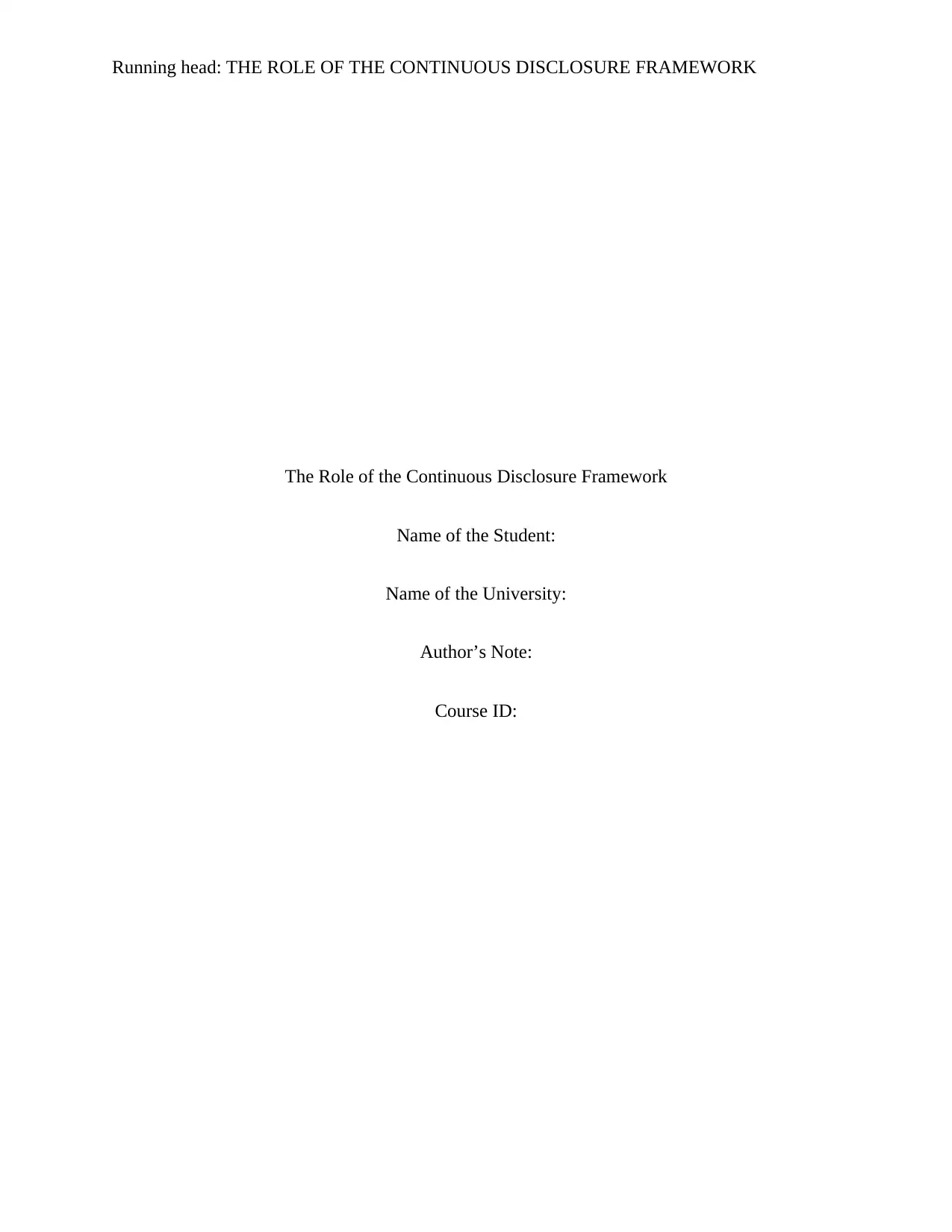
Running head: THE ROLE OF THE CONTINUOUS DISCLOSURE FRAMEWORK
The Role of the Continuous Disclosure Framework
Name of the Student:
Name of the University:
Author’s Note:
Course ID:
The Role of the Continuous Disclosure Framework
Name of the Student:
Name of the University:
Author’s Note:
Course ID:
Paraphrase This Document
Need a fresh take? Get an instant paraphrase of this document with our AI Paraphraser
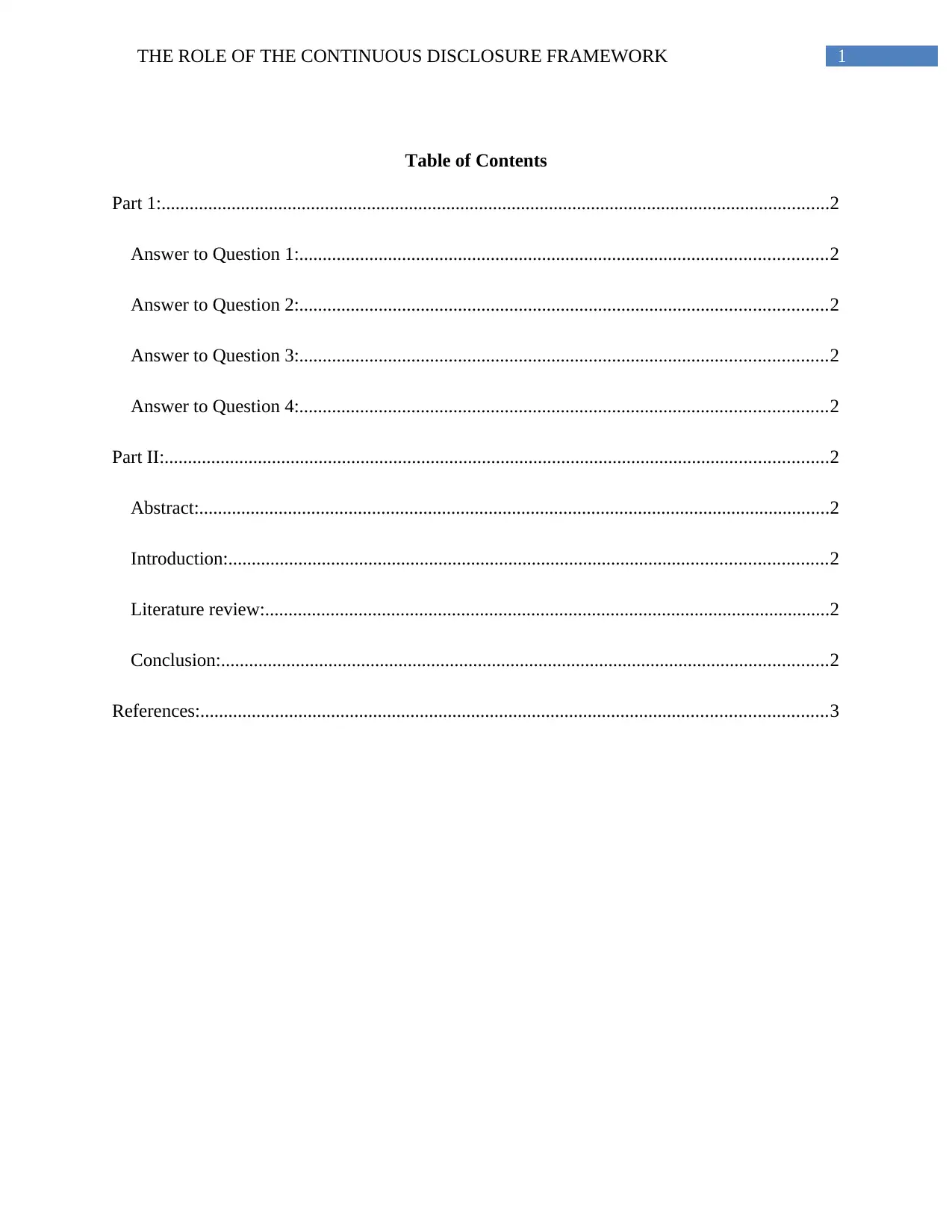
1THE ROLE OF THE CONTINUOUS DISCLOSURE FRAMEWORK
Table of Contents
Part 1:...............................................................................................................................................2
Answer to Question 1:.................................................................................................................2
Answer to Question 2:.................................................................................................................2
Answer to Question 3:.................................................................................................................2
Answer to Question 4:.................................................................................................................2
Part II:..............................................................................................................................................2
Abstract:.......................................................................................................................................2
Introduction:................................................................................................................................2
Literature review:.........................................................................................................................2
Conclusion:..................................................................................................................................2
References:......................................................................................................................................3
Table of Contents
Part 1:...............................................................................................................................................2
Answer to Question 1:.................................................................................................................2
Answer to Question 2:.................................................................................................................2
Answer to Question 3:.................................................................................................................2
Answer to Question 4:.................................................................................................................2
Part II:..............................................................................................................................................2
Abstract:.......................................................................................................................................2
Introduction:................................................................................................................................2
Literature review:.........................................................................................................................2
Conclusion:..................................................................................................................................2
References:......................................................................................................................................3
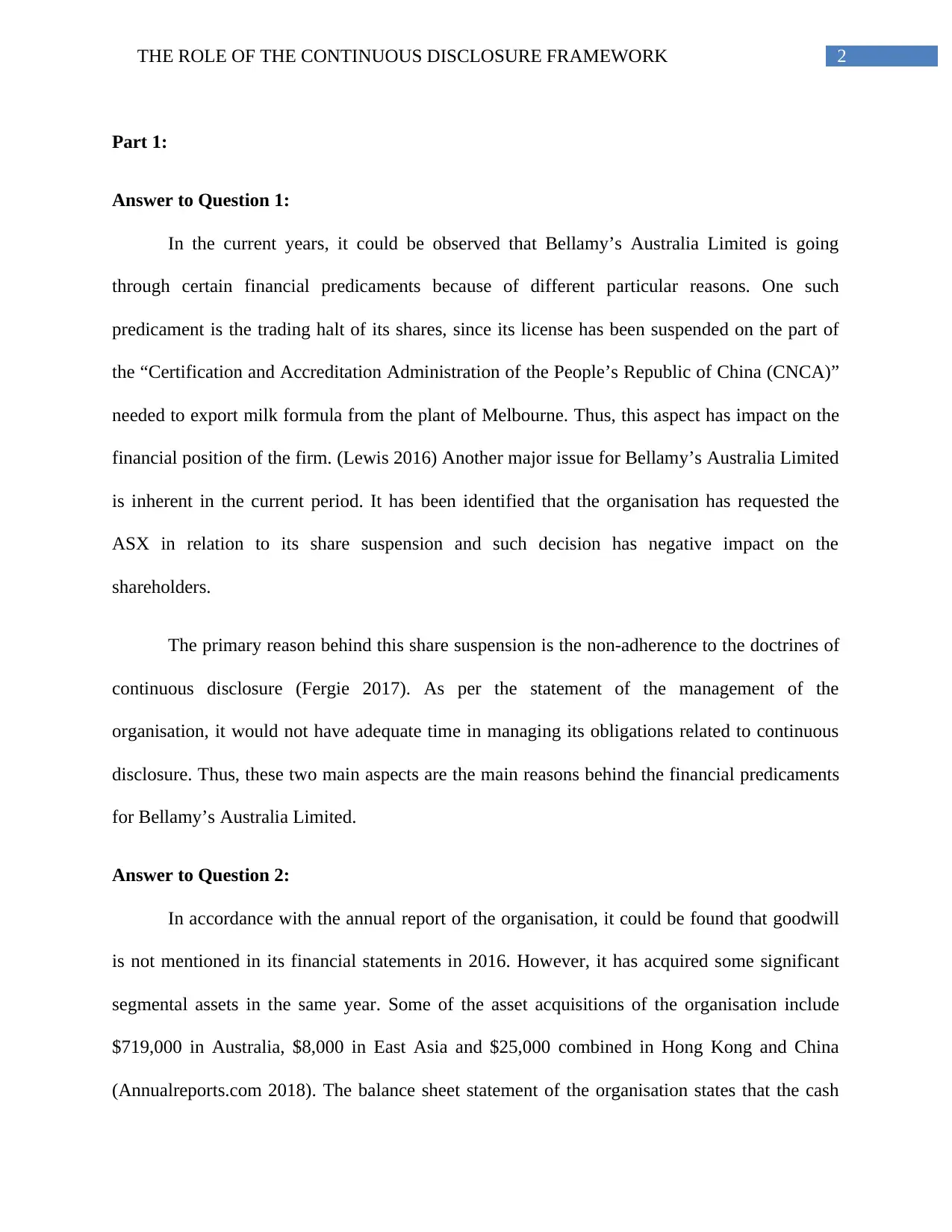
2THE ROLE OF THE CONTINUOUS DISCLOSURE FRAMEWORK
Part 1:
Answer to Question 1:
In the current years, it could be observed that Bellamy’s Australia Limited is going
through certain financial predicaments because of different particular reasons. One such
predicament is the trading halt of its shares, since its license has been suspended on the part of
the “Certification and Accreditation Administration of the People’s Republic of China (CNCA)”
needed to export milk formula from the plant of Melbourne. Thus, this aspect has impact on the
financial position of the firm. (Lewis 2016) Another major issue for Bellamy’s Australia Limited
is inherent in the current period. It has been identified that the organisation has requested the
ASX in relation to its share suspension and such decision has negative impact on the
shareholders.
The primary reason behind this share suspension is the non-adherence to the doctrines of
continuous disclosure (Fergie 2017). As per the statement of the management of the
organisation, it would not have adequate time in managing its obligations related to continuous
disclosure. Thus, these two main aspects are the main reasons behind the financial predicaments
for Bellamy’s Australia Limited.
Answer to Question 2:
In accordance with the annual report of the organisation, it could be found that goodwill
is not mentioned in its financial statements in 2016. However, it has acquired some significant
segmental assets in the same year. Some of the asset acquisitions of the organisation include
$719,000 in Australia, $8,000 in East Asia and $25,000 combined in Hong Kong and China
(Annualreports.com 2018). The balance sheet statement of the organisation states that the cash
Part 1:
Answer to Question 1:
In the current years, it could be observed that Bellamy’s Australia Limited is going
through certain financial predicaments because of different particular reasons. One such
predicament is the trading halt of its shares, since its license has been suspended on the part of
the “Certification and Accreditation Administration of the People’s Republic of China (CNCA)”
needed to export milk formula from the plant of Melbourne. Thus, this aspect has impact on the
financial position of the firm. (Lewis 2016) Another major issue for Bellamy’s Australia Limited
is inherent in the current period. It has been identified that the organisation has requested the
ASX in relation to its share suspension and such decision has negative impact on the
shareholders.
The primary reason behind this share suspension is the non-adherence to the doctrines of
continuous disclosure (Fergie 2017). As per the statement of the management of the
organisation, it would not have adequate time in managing its obligations related to continuous
disclosure. Thus, these two main aspects are the main reasons behind the financial predicaments
for Bellamy’s Australia Limited.
Answer to Question 2:
In accordance with the annual report of the organisation, it could be found that goodwill
is not mentioned in its financial statements in 2016. However, it has acquired some significant
segmental assets in the same year. Some of the asset acquisitions of the organisation include
$719,000 in Australia, $8,000 in East Asia and $25,000 combined in Hong Kong and China
(Annualreports.com 2018). The balance sheet statement of the organisation states that the cash
⊘ This is a preview!⊘
Do you want full access?
Subscribe today to unlock all pages.

Trusted by 1+ million students worldwide
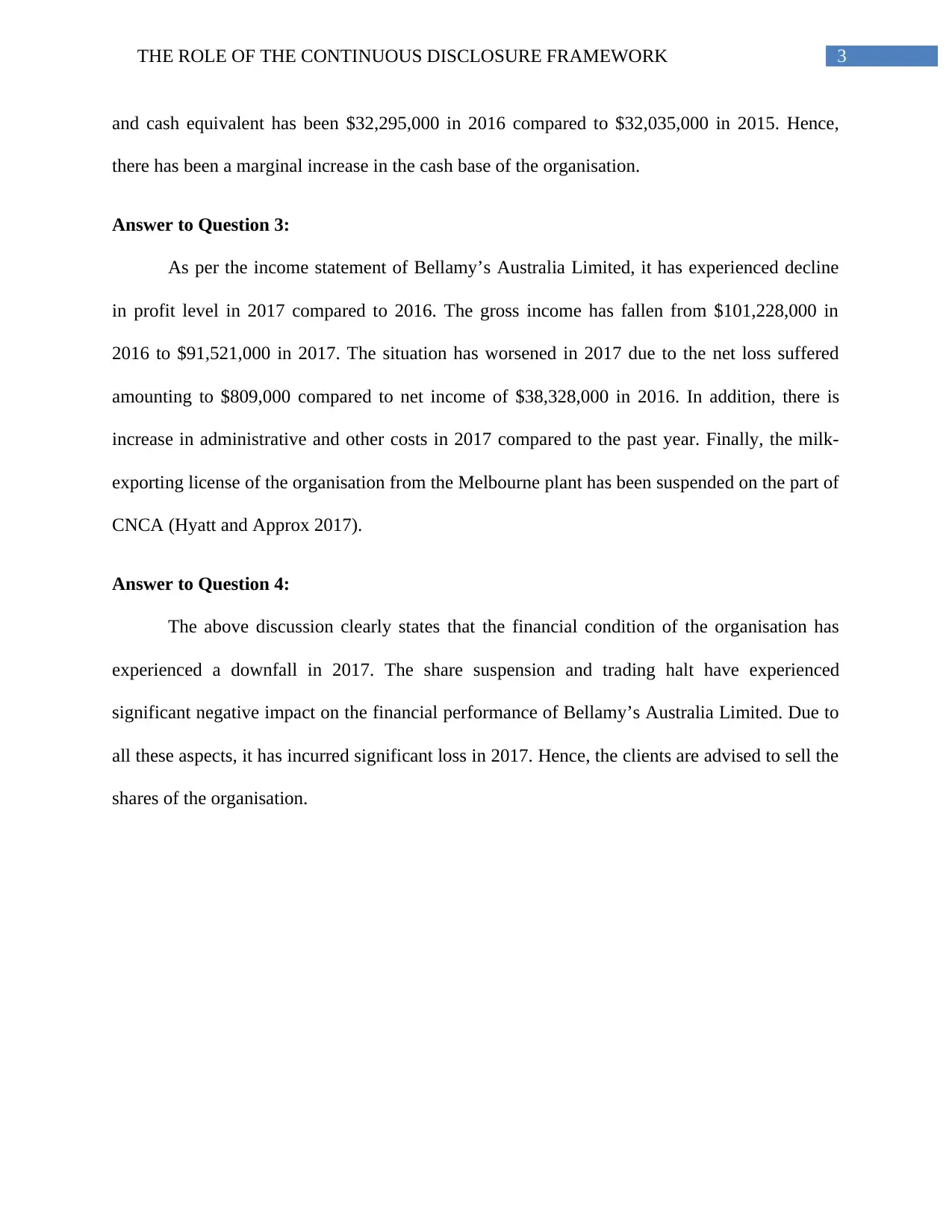
3THE ROLE OF THE CONTINUOUS DISCLOSURE FRAMEWORK
and cash equivalent has been $32,295,000 in 2016 compared to $32,035,000 in 2015. Hence,
there has been a marginal increase in the cash base of the organisation.
Answer to Question 3:
As per the income statement of Bellamy’s Australia Limited, it has experienced decline
in profit level in 2017 compared to 2016. The gross income has fallen from $101,228,000 in
2016 to $91,521,000 in 2017. The situation has worsened in 2017 due to the net loss suffered
amounting to $809,000 compared to net income of $38,328,000 in 2016. In addition, there is
increase in administrative and other costs in 2017 compared to the past year. Finally, the milk-
exporting license of the organisation from the Melbourne plant has been suspended on the part of
CNCA (Hyatt and Approx 2017).
Answer to Question 4:
The above discussion clearly states that the financial condition of the organisation has
experienced a downfall in 2017. The share suspension and trading halt have experienced
significant negative impact on the financial performance of Bellamy’s Australia Limited. Due to
all these aspects, it has incurred significant loss in 2017. Hence, the clients are advised to sell the
shares of the organisation.
and cash equivalent has been $32,295,000 in 2016 compared to $32,035,000 in 2015. Hence,
there has been a marginal increase in the cash base of the organisation.
Answer to Question 3:
As per the income statement of Bellamy’s Australia Limited, it has experienced decline
in profit level in 2017 compared to 2016. The gross income has fallen from $101,228,000 in
2016 to $91,521,000 in 2017. The situation has worsened in 2017 due to the net loss suffered
amounting to $809,000 compared to net income of $38,328,000 in 2016. In addition, there is
increase in administrative and other costs in 2017 compared to the past year. Finally, the milk-
exporting license of the organisation from the Melbourne plant has been suspended on the part of
CNCA (Hyatt and Approx 2017).
Answer to Question 4:
The above discussion clearly states that the financial condition of the organisation has
experienced a downfall in 2017. The share suspension and trading halt have experienced
significant negative impact on the financial performance of Bellamy’s Australia Limited. Due to
all these aspects, it has incurred significant loss in 2017. Hence, the clients are advised to sell the
shares of the organisation.
Paraphrase This Document
Need a fresh take? Get an instant paraphrase of this document with our AI Paraphraser
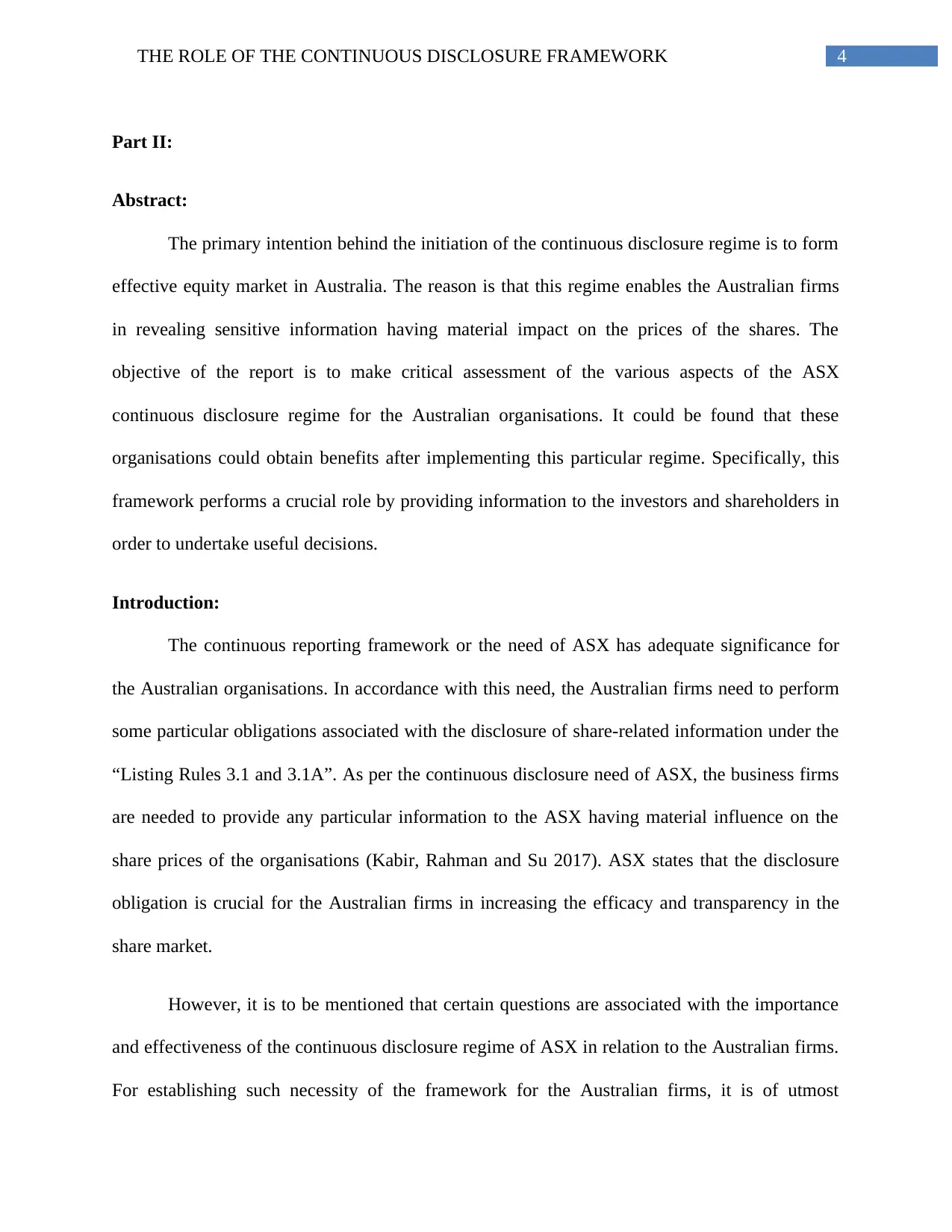
4THE ROLE OF THE CONTINUOUS DISCLOSURE FRAMEWORK
Part II:
Abstract:
The primary intention behind the initiation of the continuous disclosure regime is to form
effective equity market in Australia. The reason is that this regime enables the Australian firms
in revealing sensitive information having material impact on the prices of the shares. The
objective of the report is to make critical assessment of the various aspects of the ASX
continuous disclosure regime for the Australian organisations. It could be found that these
organisations could obtain benefits after implementing this particular regime. Specifically, this
framework performs a crucial role by providing information to the investors and shareholders in
order to undertake useful decisions.
Introduction:
The continuous reporting framework or the need of ASX has adequate significance for
the Australian organisations. In accordance with this need, the Australian firms need to perform
some particular obligations associated with the disclosure of share-related information under the
“Listing Rules 3.1 and 3.1A”. As per the continuous disclosure need of ASX, the business firms
are needed to provide any particular information to the ASX having material influence on the
share prices of the organisations (Kabir, Rahman and Su 2017). ASX states that the disclosure
obligation is crucial for the Australian firms in increasing the efficacy and transparency in the
share market.
However, it is to be mentioned that certain questions are associated with the importance
and effectiveness of the continuous disclosure regime of ASX in relation to the Australian firms.
For establishing such necessity of the framework for the Australian firms, it is of utmost
Part II:
Abstract:
The primary intention behind the initiation of the continuous disclosure regime is to form
effective equity market in Australia. The reason is that this regime enables the Australian firms
in revealing sensitive information having material impact on the prices of the shares. The
objective of the report is to make critical assessment of the various aspects of the ASX
continuous disclosure regime for the Australian organisations. It could be found that these
organisations could obtain benefits after implementing this particular regime. Specifically, this
framework performs a crucial role by providing information to the investors and shareholders in
order to undertake useful decisions.
Introduction:
The continuous reporting framework or the need of ASX has adequate significance for
the Australian organisations. In accordance with this need, the Australian firms need to perform
some particular obligations associated with the disclosure of share-related information under the
“Listing Rules 3.1 and 3.1A”. As per the continuous disclosure need of ASX, the business firms
are needed to provide any particular information to the ASX having material influence on the
share prices of the organisations (Kabir, Rahman and Su 2017). ASX states that the disclosure
obligation is crucial for the Australian firms in increasing the efficacy and transparency in the
share market.
However, it is to be mentioned that certain questions are associated with the importance
and effectiveness of the continuous disclosure regime of ASX in relation to the Australian firms.
For establishing such necessity of the framework for the Australian firms, it is of utmost
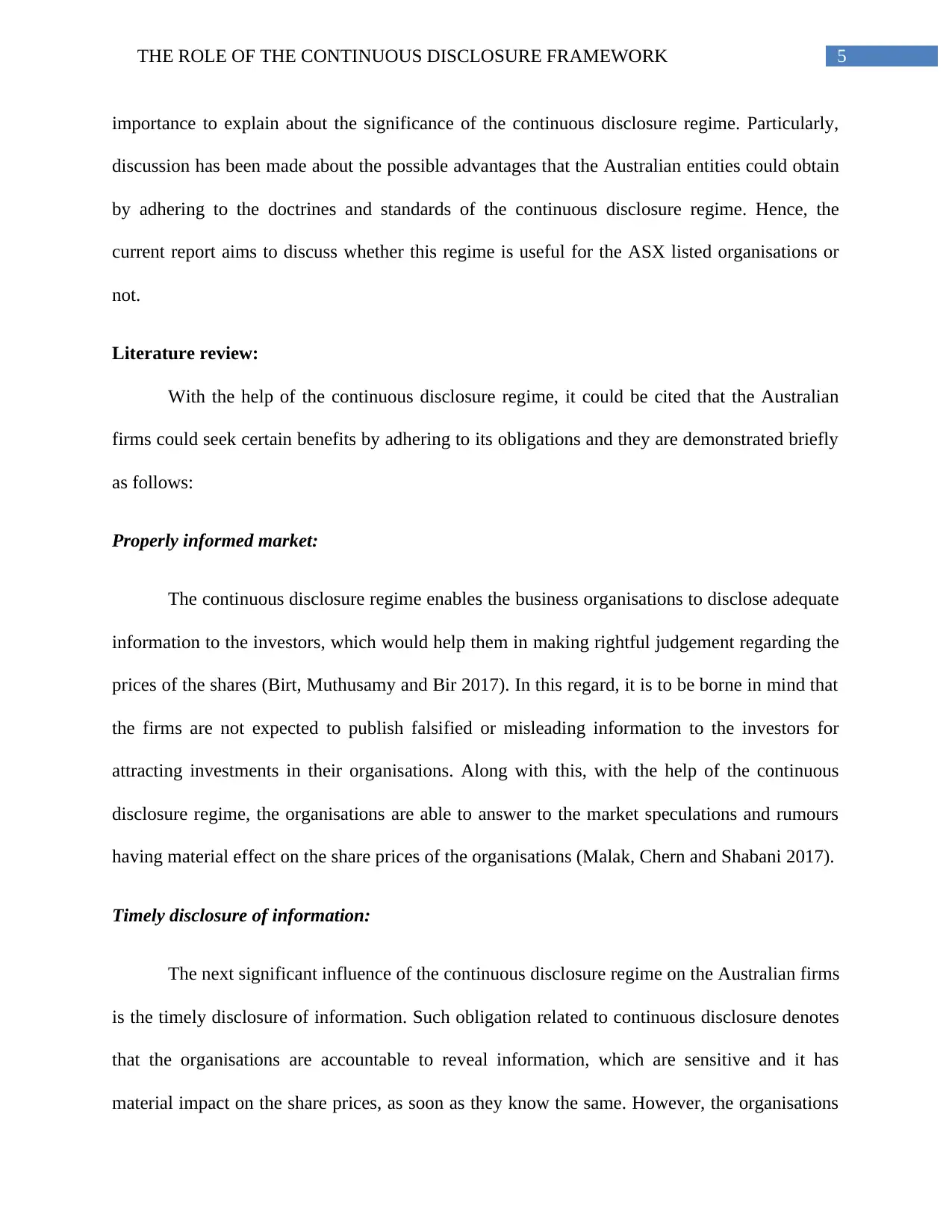
5THE ROLE OF THE CONTINUOUS DISCLOSURE FRAMEWORK
importance to explain about the significance of the continuous disclosure regime. Particularly,
discussion has been made about the possible advantages that the Australian entities could obtain
by adhering to the doctrines and standards of the continuous disclosure regime. Hence, the
current report aims to discuss whether this regime is useful for the ASX listed organisations or
not.
Literature review:
With the help of the continuous disclosure regime, it could be cited that the Australian
firms could seek certain benefits by adhering to its obligations and they are demonstrated briefly
as follows:
Properly informed market:
The continuous disclosure regime enables the business organisations to disclose adequate
information to the investors, which would help them in making rightful judgement regarding the
prices of the shares (Birt, Muthusamy and Bir 2017). In this regard, it is to be borne in mind that
the firms are not expected to publish falsified or misleading information to the investors for
attracting investments in their organisations. Along with this, with the help of the continuous
disclosure regime, the organisations are able to answer to the market speculations and rumours
having material effect on the share prices of the organisations (Malak, Chern and Shabani 2017).
Timely disclosure of information:
The next significant influence of the continuous disclosure regime on the Australian firms
is the timely disclosure of information. Such obligation related to continuous disclosure denotes
that the organisations are accountable to reveal information, which are sensitive and it has
material impact on the share prices, as soon as they know the same. However, the organisations
importance to explain about the significance of the continuous disclosure regime. Particularly,
discussion has been made about the possible advantages that the Australian entities could obtain
by adhering to the doctrines and standards of the continuous disclosure regime. Hence, the
current report aims to discuss whether this regime is useful for the ASX listed organisations or
not.
Literature review:
With the help of the continuous disclosure regime, it could be cited that the Australian
firms could seek certain benefits by adhering to its obligations and they are demonstrated briefly
as follows:
Properly informed market:
The continuous disclosure regime enables the business organisations to disclose adequate
information to the investors, which would help them in making rightful judgement regarding the
prices of the shares (Birt, Muthusamy and Bir 2017). In this regard, it is to be borne in mind that
the firms are not expected to publish falsified or misleading information to the investors for
attracting investments in their organisations. Along with this, with the help of the continuous
disclosure regime, the organisations are able to answer to the market speculations and rumours
having material effect on the share prices of the organisations (Malak, Chern and Shabani 2017).
Timely disclosure of information:
The next significant influence of the continuous disclosure regime on the Australian firms
is the timely disclosure of information. Such obligation related to continuous disclosure denotes
that the organisations are accountable to reveal information, which are sensitive and it has
material impact on the share prices, as soon as they know the same. However, the organisations
⊘ This is a preview!⊘
Do you want full access?
Subscribe today to unlock all pages.

Trusted by 1+ million students worldwide
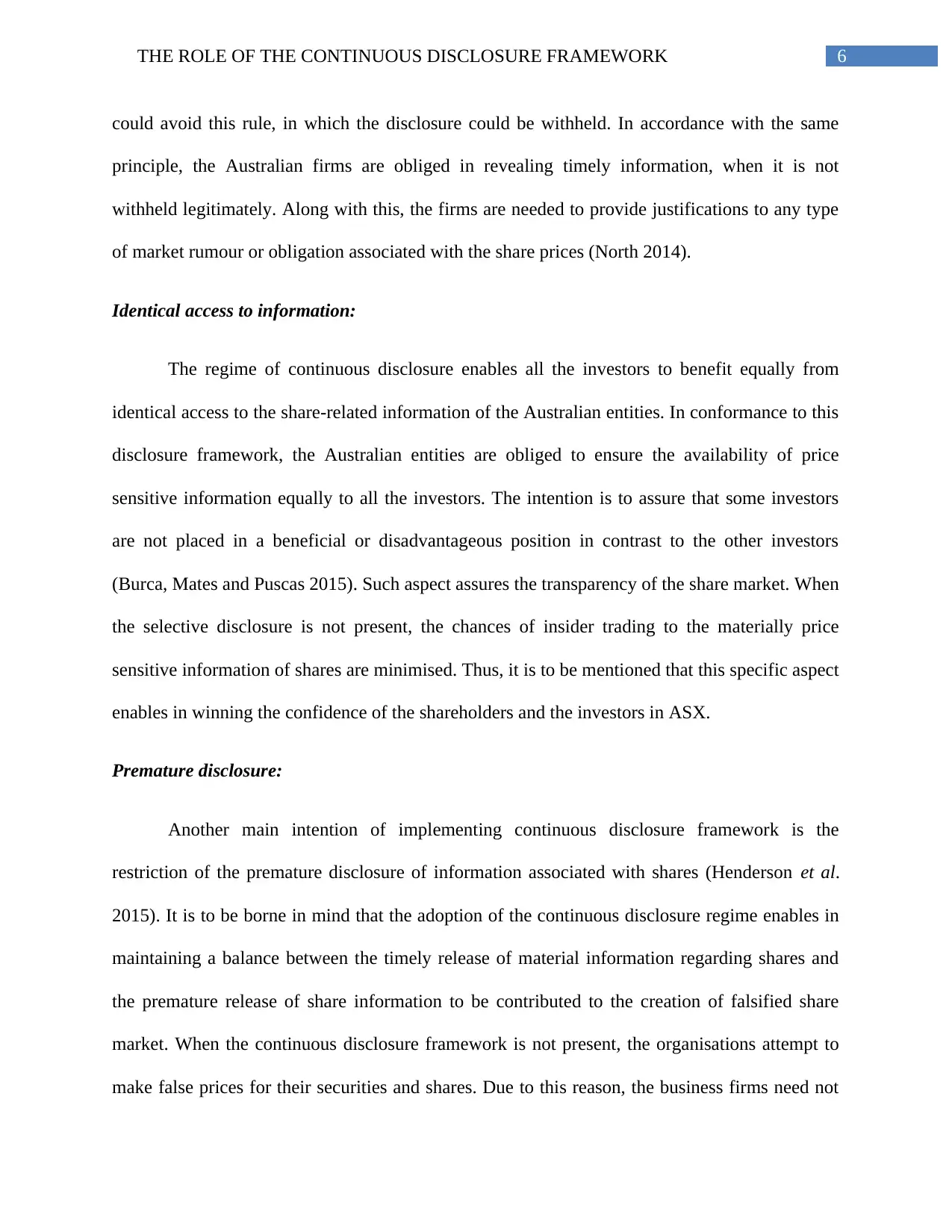
6THE ROLE OF THE CONTINUOUS DISCLOSURE FRAMEWORK
could avoid this rule, in which the disclosure could be withheld. In accordance with the same
principle, the Australian firms are obliged in revealing timely information, when it is not
withheld legitimately. Along with this, the firms are needed to provide justifications to any type
of market rumour or obligation associated with the share prices (North 2014).
Identical access to information:
The regime of continuous disclosure enables all the investors to benefit equally from
identical access to the share-related information of the Australian entities. In conformance to this
disclosure framework, the Australian entities are obliged to ensure the availability of price
sensitive information equally to all the investors. The intention is to assure that some investors
are not placed in a beneficial or disadvantageous position in contrast to the other investors
(Burca, Mates and Puscas 2015). Such aspect assures the transparency of the share market. When
the selective disclosure is not present, the chances of insider trading to the materially price
sensitive information of shares are minimised. Thus, it is to be mentioned that this specific aspect
enables in winning the confidence of the shareholders and the investors in ASX.
Premature disclosure:
Another main intention of implementing continuous disclosure framework is the
restriction of the premature disclosure of information associated with shares (Henderson et al.
2015). It is to be borne in mind that the adoption of the continuous disclosure regime enables in
maintaining a balance between the timely release of material information regarding shares and
the premature release of share information to be contributed to the creation of falsified share
market. When the continuous disclosure framework is not present, the organisations attempt to
make false prices for their securities and shares. Due to this reason, the business firms need not
could avoid this rule, in which the disclosure could be withheld. In accordance with the same
principle, the Australian firms are obliged in revealing timely information, when it is not
withheld legitimately. Along with this, the firms are needed to provide justifications to any type
of market rumour or obligation associated with the share prices (North 2014).
Identical access to information:
The regime of continuous disclosure enables all the investors to benefit equally from
identical access to the share-related information of the Australian entities. In conformance to this
disclosure framework, the Australian entities are obliged to ensure the availability of price
sensitive information equally to all the investors. The intention is to assure that some investors
are not placed in a beneficial or disadvantageous position in contrast to the other investors
(Burca, Mates and Puscas 2015). Such aspect assures the transparency of the share market. When
the selective disclosure is not present, the chances of insider trading to the materially price
sensitive information of shares are minimised. Thus, it is to be mentioned that this specific aspect
enables in winning the confidence of the shareholders and the investors in ASX.
Premature disclosure:
Another main intention of implementing continuous disclosure framework is the
restriction of the premature disclosure of information associated with shares (Henderson et al.
2015). It is to be borne in mind that the adoption of the continuous disclosure regime enables in
maintaining a balance between the timely release of material information regarding shares and
the premature release of share information to be contributed to the creation of falsified share
market. When the continuous disclosure framework is not present, the organisations attempt to
make false prices for their securities and shares. Due to this reason, the business firms need not
Paraphrase This Document
Need a fresh take? Get an instant paraphrase of this document with our AI Paraphraser
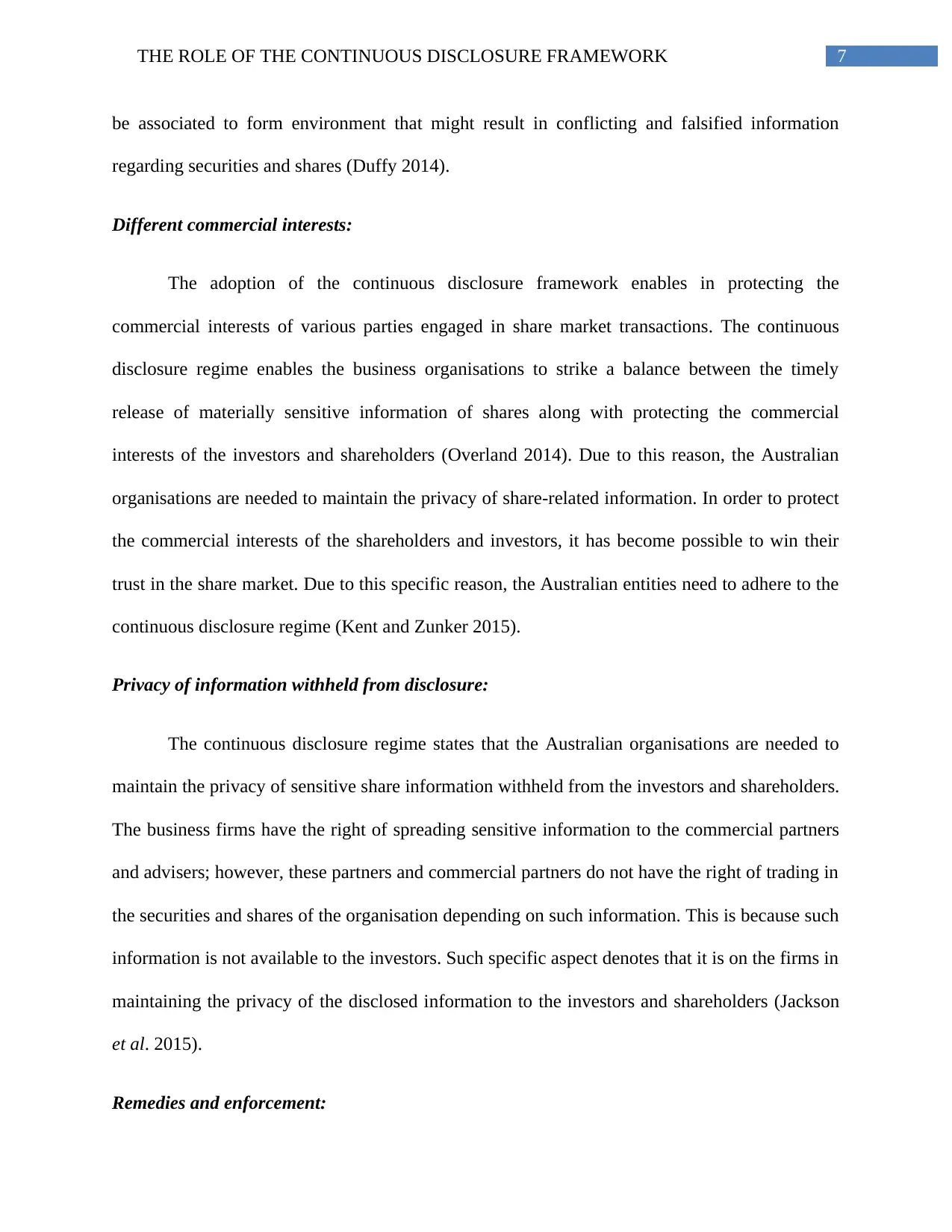
7THE ROLE OF THE CONTINUOUS DISCLOSURE FRAMEWORK
be associated to form environment that might result in conflicting and falsified information
regarding securities and shares (Duffy 2014).
Different commercial interests:
The adoption of the continuous disclosure framework enables in protecting the
commercial interests of various parties engaged in share market transactions. The continuous
disclosure regime enables the business organisations to strike a balance between the timely
release of materially sensitive information of shares along with protecting the commercial
interests of the investors and shareholders (Overland 2014). Due to this reason, the Australian
organisations are needed to maintain the privacy of share-related information. In order to protect
the commercial interests of the shareholders and investors, it has become possible to win their
trust in the share market. Due to this specific reason, the Australian entities need to adhere to the
continuous disclosure regime (Kent and Zunker 2015).
Privacy of information withheld from disclosure:
The continuous disclosure regime states that the Australian organisations are needed to
maintain the privacy of sensitive share information withheld from the investors and shareholders.
The business firms have the right of spreading sensitive information to the commercial partners
and advisers; however, these partners and commercial partners do not have the right of trading in
the securities and shares of the organisation depending on such information. This is because such
information is not available to the investors. Such specific aspect denotes that it is on the firms in
maintaining the privacy of the disclosed information to the investors and shareholders (Jackson
et al. 2015).
Remedies and enforcement:
be associated to form environment that might result in conflicting and falsified information
regarding securities and shares (Duffy 2014).
Different commercial interests:
The adoption of the continuous disclosure framework enables in protecting the
commercial interests of various parties engaged in share market transactions. The continuous
disclosure regime enables the business organisations to strike a balance between the timely
release of materially sensitive information of shares along with protecting the commercial
interests of the investors and shareholders (Overland 2014). Due to this reason, the Australian
organisations are needed to maintain the privacy of share-related information. In order to protect
the commercial interests of the shareholders and investors, it has become possible to win their
trust in the share market. Due to this specific reason, the Australian entities need to adhere to the
continuous disclosure regime (Kent and Zunker 2015).
Privacy of information withheld from disclosure:
The continuous disclosure regime states that the Australian organisations are needed to
maintain the privacy of sensitive share information withheld from the investors and shareholders.
The business firms have the right of spreading sensitive information to the commercial partners
and advisers; however, these partners and commercial partners do not have the right of trading in
the securities and shares of the organisation depending on such information. This is because such
information is not available to the investors. Such specific aspect denotes that it is on the firms in
maintaining the privacy of the disclosed information to the investors and shareholders (Jackson
et al. 2015).
Remedies and enforcement:
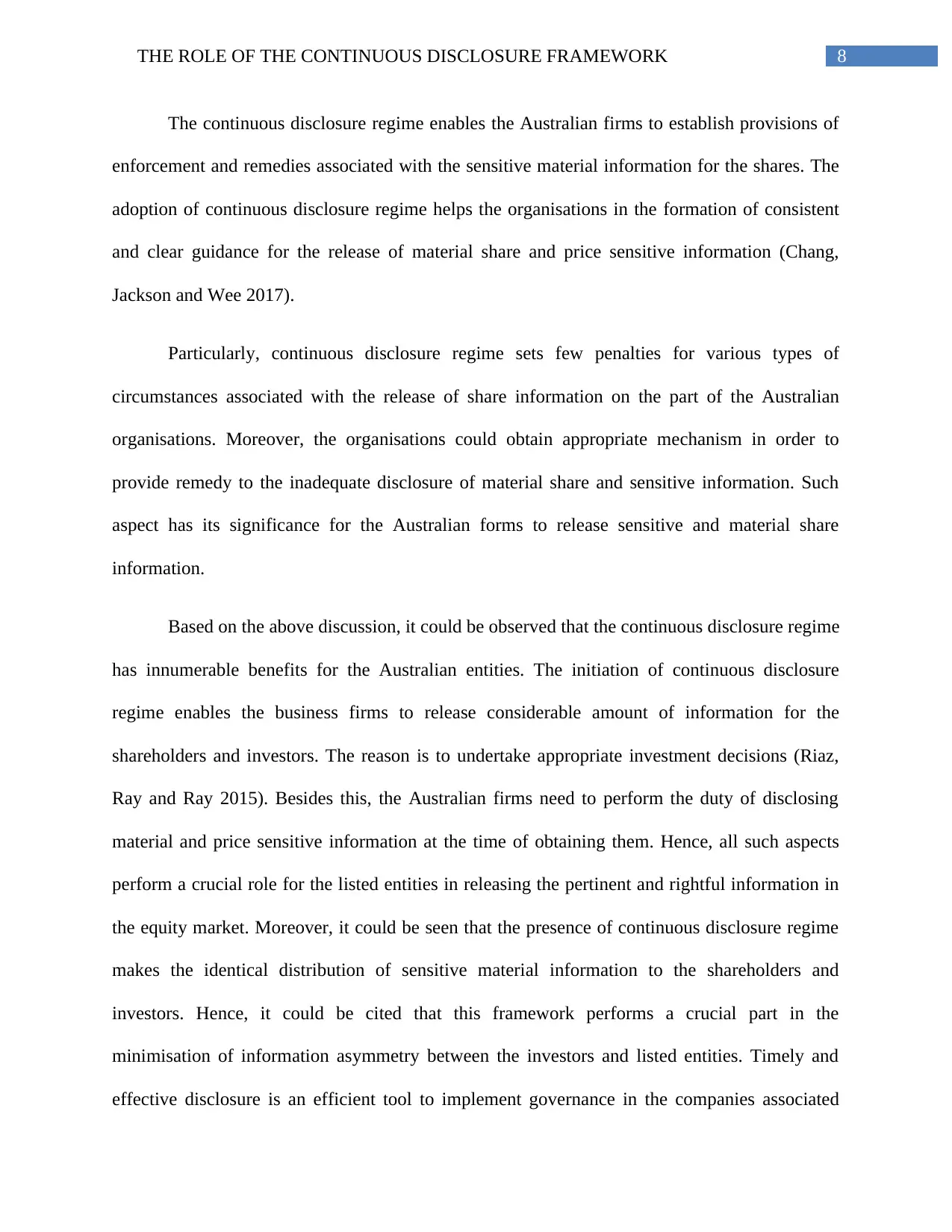
8THE ROLE OF THE CONTINUOUS DISCLOSURE FRAMEWORK
The continuous disclosure regime enables the Australian firms to establish provisions of
enforcement and remedies associated with the sensitive material information for the shares. The
adoption of continuous disclosure regime helps the organisations in the formation of consistent
and clear guidance for the release of material share and price sensitive information (Chang,
Jackson and Wee 2017).
Particularly, continuous disclosure regime sets few penalties for various types of
circumstances associated with the release of share information on the part of the Australian
organisations. Moreover, the organisations could obtain appropriate mechanism in order to
provide remedy to the inadequate disclosure of material share and sensitive information. Such
aspect has its significance for the Australian forms to release sensitive and material share
information.
Based on the above discussion, it could be observed that the continuous disclosure regime
has innumerable benefits for the Australian entities. The initiation of continuous disclosure
regime enables the business firms to release considerable amount of information for the
shareholders and investors. The reason is to undertake appropriate investment decisions (Riaz,
Ray and Ray 2015). Besides this, the Australian firms need to perform the duty of disclosing
material and price sensitive information at the time of obtaining them. Hence, all such aspects
perform a crucial role for the listed entities in releasing the pertinent and rightful information in
the equity market. Moreover, it could be seen that the presence of continuous disclosure regime
makes the identical distribution of sensitive material information to the shareholders and
investors. Hence, it could be cited that this framework performs a crucial part in the
minimisation of information asymmetry between the investors and listed entities. Timely and
effective disclosure is an efficient tool to implement governance in the companies associated
The continuous disclosure regime enables the Australian firms to establish provisions of
enforcement and remedies associated with the sensitive material information for the shares. The
adoption of continuous disclosure regime helps the organisations in the formation of consistent
and clear guidance for the release of material share and price sensitive information (Chang,
Jackson and Wee 2017).
Particularly, continuous disclosure regime sets few penalties for various types of
circumstances associated with the release of share information on the part of the Australian
organisations. Moreover, the organisations could obtain appropriate mechanism in order to
provide remedy to the inadequate disclosure of material share and sensitive information. Such
aspect has its significance for the Australian forms to release sensitive and material share
information.
Based on the above discussion, it could be observed that the continuous disclosure regime
has innumerable benefits for the Australian entities. The initiation of continuous disclosure
regime enables the business firms to release considerable amount of information for the
shareholders and investors. The reason is to undertake appropriate investment decisions (Riaz,
Ray and Ray 2015). Besides this, the Australian firms need to perform the duty of disclosing
material and price sensitive information at the time of obtaining them. Hence, all such aspects
perform a crucial role for the listed entities in releasing the pertinent and rightful information in
the equity market. Moreover, it could be seen that the presence of continuous disclosure regime
makes the identical distribution of sensitive material information to the shareholders and
investors. Hence, it could be cited that this framework performs a crucial part in the
minimisation of information asymmetry between the investors and listed entities. Timely and
effective disclosure is an efficient tool to implement governance in the companies associated
⊘ This is a preview!⊘
Do you want full access?
Subscribe today to unlock all pages.

Trusted by 1+ million students worldwide
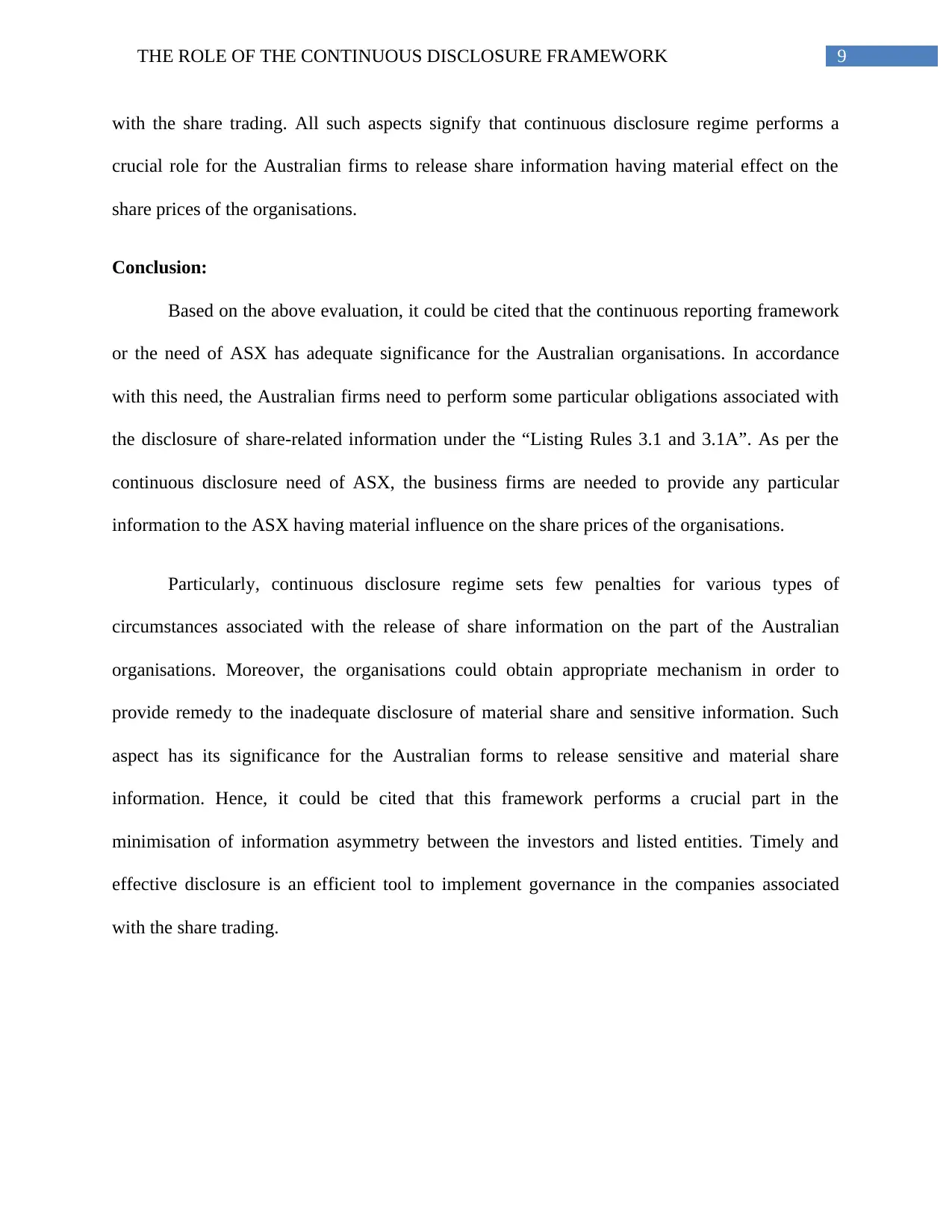
9THE ROLE OF THE CONTINUOUS DISCLOSURE FRAMEWORK
with the share trading. All such aspects signify that continuous disclosure regime performs a
crucial role for the Australian firms to release share information having material effect on the
share prices of the organisations.
Conclusion:
Based on the above evaluation, it could be cited that the continuous reporting framework
or the need of ASX has adequate significance for the Australian organisations. In accordance
with this need, the Australian firms need to perform some particular obligations associated with
the disclosure of share-related information under the “Listing Rules 3.1 and 3.1A”. As per the
continuous disclosure need of ASX, the business firms are needed to provide any particular
information to the ASX having material influence on the share prices of the organisations.
Particularly, continuous disclosure regime sets few penalties for various types of
circumstances associated with the release of share information on the part of the Australian
organisations. Moreover, the organisations could obtain appropriate mechanism in order to
provide remedy to the inadequate disclosure of material share and sensitive information. Such
aspect has its significance for the Australian forms to release sensitive and material share
information. Hence, it could be cited that this framework performs a crucial part in the
minimisation of information asymmetry between the investors and listed entities. Timely and
effective disclosure is an efficient tool to implement governance in the companies associated
with the share trading.
with the share trading. All such aspects signify that continuous disclosure regime performs a
crucial role for the Australian firms to release share information having material effect on the
share prices of the organisations.
Conclusion:
Based on the above evaluation, it could be cited that the continuous reporting framework
or the need of ASX has adequate significance for the Australian organisations. In accordance
with this need, the Australian firms need to perform some particular obligations associated with
the disclosure of share-related information under the “Listing Rules 3.1 and 3.1A”. As per the
continuous disclosure need of ASX, the business firms are needed to provide any particular
information to the ASX having material influence on the share prices of the organisations.
Particularly, continuous disclosure regime sets few penalties for various types of
circumstances associated with the release of share information on the part of the Australian
organisations. Moreover, the organisations could obtain appropriate mechanism in order to
provide remedy to the inadequate disclosure of material share and sensitive information. Such
aspect has its significance for the Australian forms to release sensitive and material share
information. Hence, it could be cited that this framework performs a crucial part in the
minimisation of information asymmetry between the investors and listed entities. Timely and
effective disclosure is an efficient tool to implement governance in the companies associated
with the share trading.
Paraphrase This Document
Need a fresh take? Get an instant paraphrase of this document with our AI Paraphraser
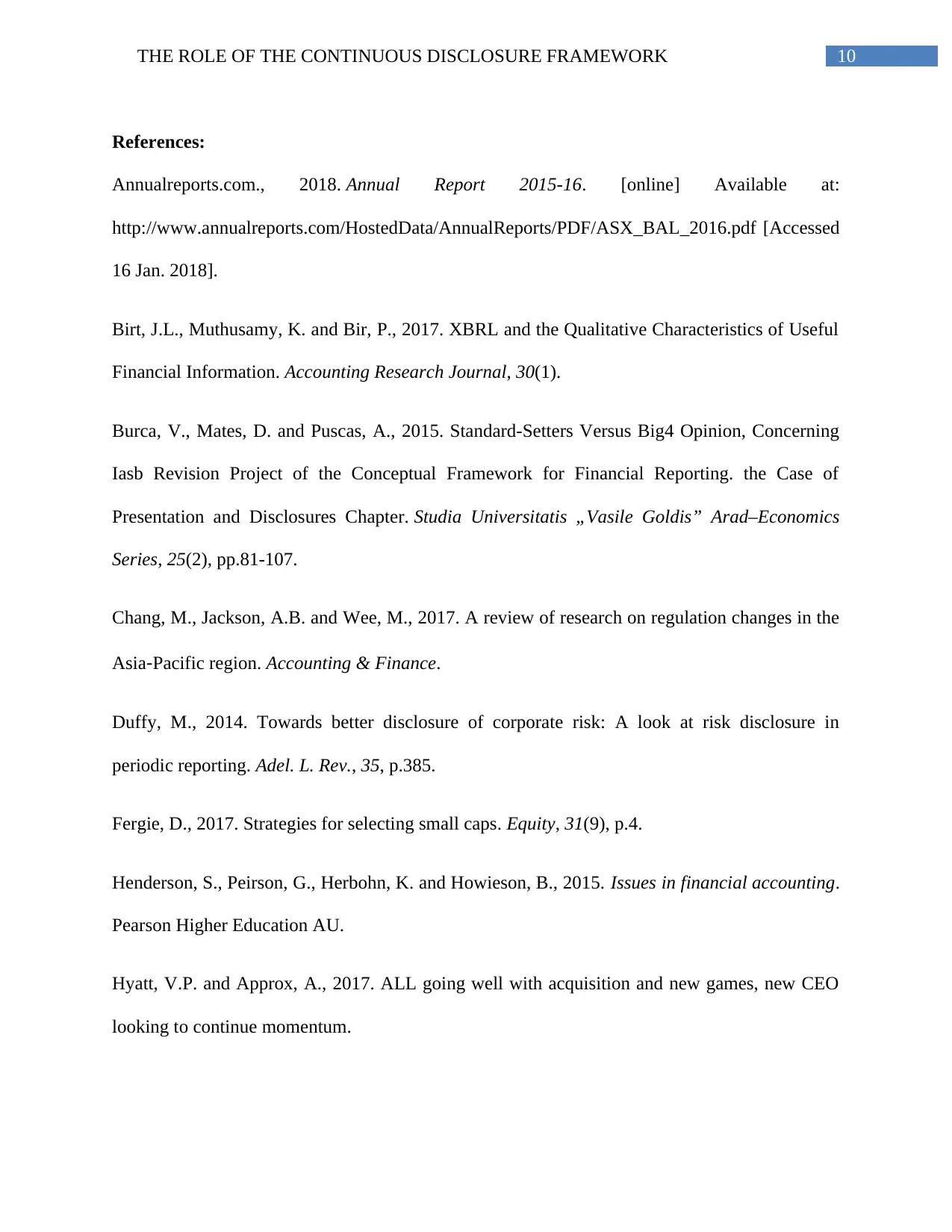
10THE ROLE OF THE CONTINUOUS DISCLOSURE FRAMEWORK
References:
Annualreports.com., 2018. Annual Report 2015-16. [online] Available at:
http://www.annualreports.com/HostedData/AnnualReports/PDF/ASX_BAL_2016.pdf [Accessed
16 Jan. 2018].
Birt, J.L., Muthusamy, K. and Bir, P., 2017. XBRL and the Qualitative Characteristics of Useful
Financial Information. Accounting Research Journal, 30(1).
Burca, V., Mates, D. and Puscas, A., 2015. Standard-Setters Versus Big4 Opinion, Concerning
Iasb Revision Project of the Conceptual Framework for Financial Reporting. the Case of
Presentation and Disclosures Chapter. Studia Universitatis „Vasile Goldis” Arad–Economics
Series, 25(2), pp.81-107.
Chang, M., Jackson, A.B. and Wee, M., 2017. A review of research on regulation changes in the
Asia‐Pacific region. Accounting & Finance.
Duffy, M., 2014. Towards better disclosure of corporate risk: A look at risk disclosure in
periodic reporting. Adel. L. Rev., 35, p.385.
Fergie, D., 2017. Strategies for selecting small caps. Equity, 31(9), p.4.
Henderson, S., Peirson, G., Herbohn, K. and Howieson, B., 2015. Issues in financial accounting.
Pearson Higher Education AU.
Hyatt, V.P. and Approx, A., 2017. ALL going well with acquisition and new games, new CEO
looking to continue momentum.
References:
Annualreports.com., 2018. Annual Report 2015-16. [online] Available at:
http://www.annualreports.com/HostedData/AnnualReports/PDF/ASX_BAL_2016.pdf [Accessed
16 Jan. 2018].
Birt, J.L., Muthusamy, K. and Bir, P., 2017. XBRL and the Qualitative Characteristics of Useful
Financial Information. Accounting Research Journal, 30(1).
Burca, V., Mates, D. and Puscas, A., 2015. Standard-Setters Versus Big4 Opinion, Concerning
Iasb Revision Project of the Conceptual Framework for Financial Reporting. the Case of
Presentation and Disclosures Chapter. Studia Universitatis „Vasile Goldis” Arad–Economics
Series, 25(2), pp.81-107.
Chang, M., Jackson, A.B. and Wee, M., 2017. A review of research on regulation changes in the
Asia‐Pacific region. Accounting & Finance.
Duffy, M., 2014. Towards better disclosure of corporate risk: A look at risk disclosure in
periodic reporting. Adel. L. Rev., 35, p.385.
Fergie, D., 2017. Strategies for selecting small caps. Equity, 31(9), p.4.
Henderson, S., Peirson, G., Herbohn, K. and Howieson, B., 2015. Issues in financial accounting.
Pearson Higher Education AU.
Hyatt, V.P. and Approx, A., 2017. ALL going well with acquisition and new games, new CEO
looking to continue momentum.
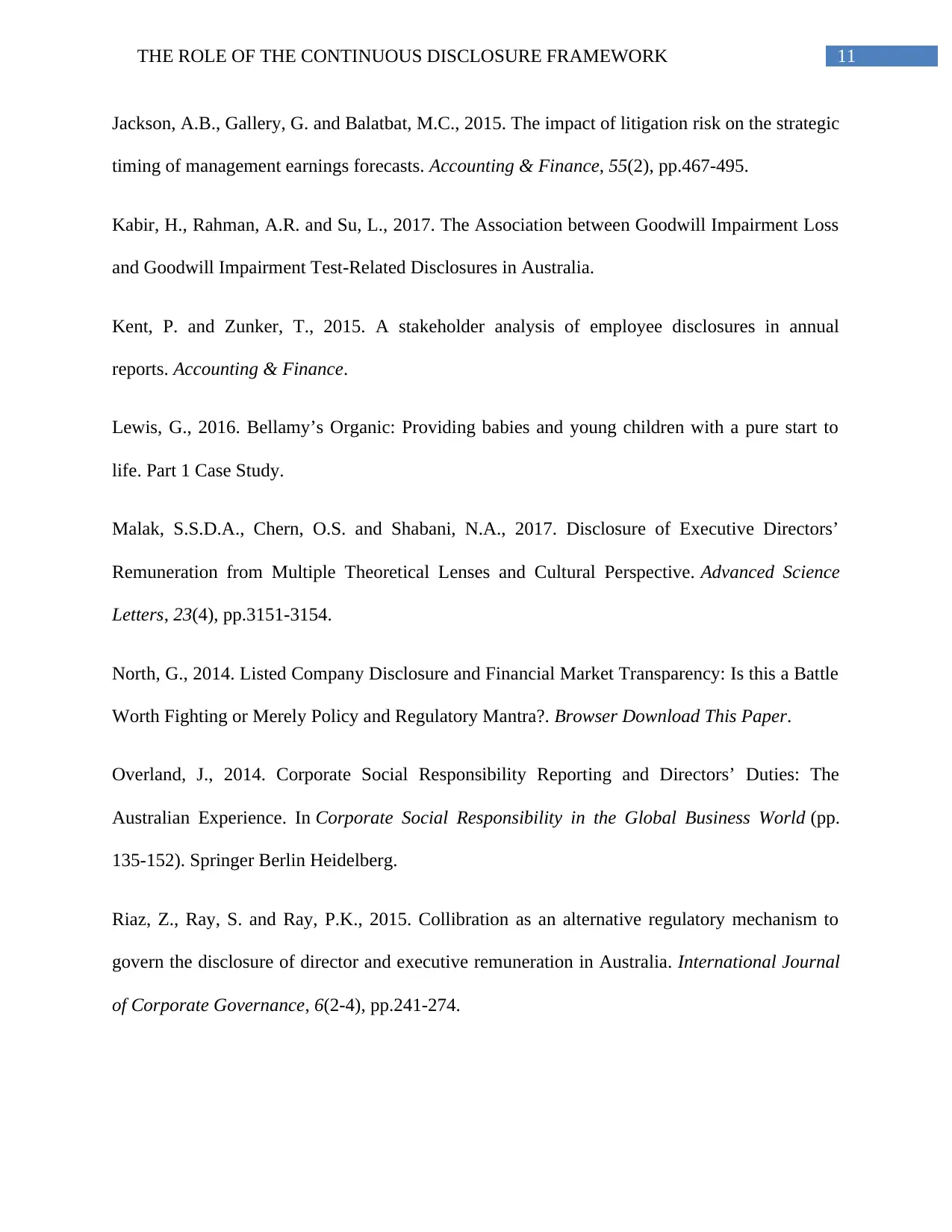
11THE ROLE OF THE CONTINUOUS DISCLOSURE FRAMEWORK
Jackson, A.B., Gallery, G. and Balatbat, M.C., 2015. The impact of litigation risk on the strategic
timing of management earnings forecasts. Accounting & Finance, 55(2), pp.467-495.
Kabir, H., Rahman, A.R. and Su, L., 2017. The Association between Goodwill Impairment Loss
and Goodwill Impairment Test-Related Disclosures in Australia.
Kent, P. and Zunker, T., 2015. A stakeholder analysis of employee disclosures in annual
reports. Accounting & Finance.
Lewis, G., 2016. Bellamy’s Organic: Providing babies and young children with a pure start to
life. Part 1 Case Study.
Malak, S.S.D.A., Chern, O.S. and Shabani, N.A., 2017. Disclosure of Executive Directors’
Remuneration from Multiple Theoretical Lenses and Cultural Perspective. Advanced Science
Letters, 23(4), pp.3151-3154.
North, G., 2014. Listed Company Disclosure and Financial Market Transparency: Is this a Battle
Worth Fighting or Merely Policy and Regulatory Mantra?. Browser Download This Paper.
Overland, J., 2014. Corporate Social Responsibility Reporting and Directors’ Duties: The
Australian Experience. In Corporate Social Responsibility in the Global Business World (pp.
135-152). Springer Berlin Heidelberg.
Riaz, Z., Ray, S. and Ray, P.K., 2015. Collibration as an alternative regulatory mechanism to
govern the disclosure of director and executive remuneration in Australia. International Journal
of Corporate Governance, 6(2-4), pp.241-274.
Jackson, A.B., Gallery, G. and Balatbat, M.C., 2015. The impact of litigation risk on the strategic
timing of management earnings forecasts. Accounting & Finance, 55(2), pp.467-495.
Kabir, H., Rahman, A.R. and Su, L., 2017. The Association between Goodwill Impairment Loss
and Goodwill Impairment Test-Related Disclosures in Australia.
Kent, P. and Zunker, T., 2015. A stakeholder analysis of employee disclosures in annual
reports. Accounting & Finance.
Lewis, G., 2016. Bellamy’s Organic: Providing babies and young children with a pure start to
life. Part 1 Case Study.
Malak, S.S.D.A., Chern, O.S. and Shabani, N.A., 2017. Disclosure of Executive Directors’
Remuneration from Multiple Theoretical Lenses and Cultural Perspective. Advanced Science
Letters, 23(4), pp.3151-3154.
North, G., 2014. Listed Company Disclosure and Financial Market Transparency: Is this a Battle
Worth Fighting or Merely Policy and Regulatory Mantra?. Browser Download This Paper.
Overland, J., 2014. Corporate Social Responsibility Reporting and Directors’ Duties: The
Australian Experience. In Corporate Social Responsibility in the Global Business World (pp.
135-152). Springer Berlin Heidelberg.
Riaz, Z., Ray, S. and Ray, P.K., 2015. Collibration as an alternative regulatory mechanism to
govern the disclosure of director and executive remuneration in Australia. International Journal
of Corporate Governance, 6(2-4), pp.241-274.
⊘ This is a preview!⊘
Do you want full access?
Subscribe today to unlock all pages.

Trusted by 1+ million students worldwide
1 out of 13
Related Documents
Your All-in-One AI-Powered Toolkit for Academic Success.
+13062052269
info@desklib.com
Available 24*7 on WhatsApp / Email
![[object Object]](/_next/static/media/star-bottom.7253800d.svg)
Unlock your academic potential
Copyright © 2020–2025 A2Z Services. All Rights Reserved. Developed and managed by ZUCOL.





